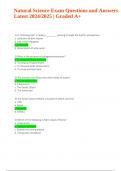Summary
Summary Targeting cellular processes to treat disease - Everything you need to know
- Course
- Institution
- Book
Contains everything you need to know for the exam (papers, assigments, SSA's, lectures). Only the chapters from the book are missing from chapter 10 onwards.
[Show more]













